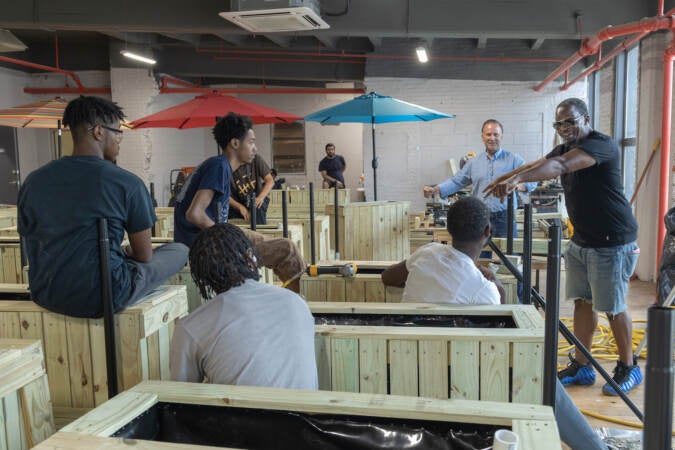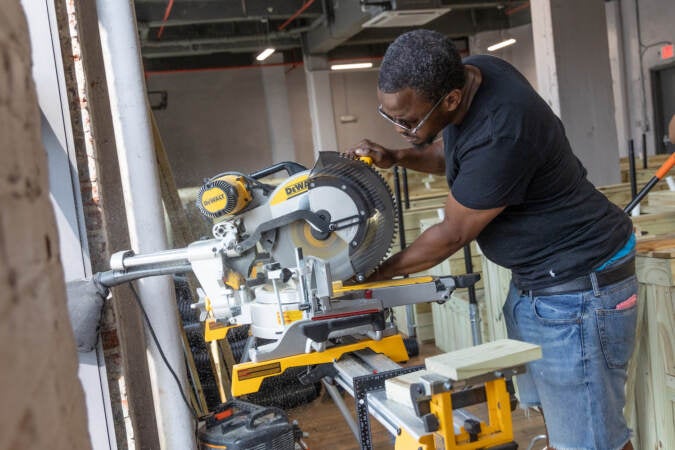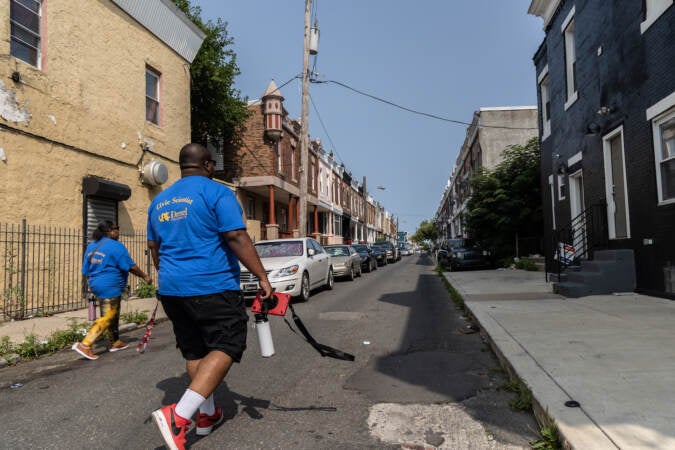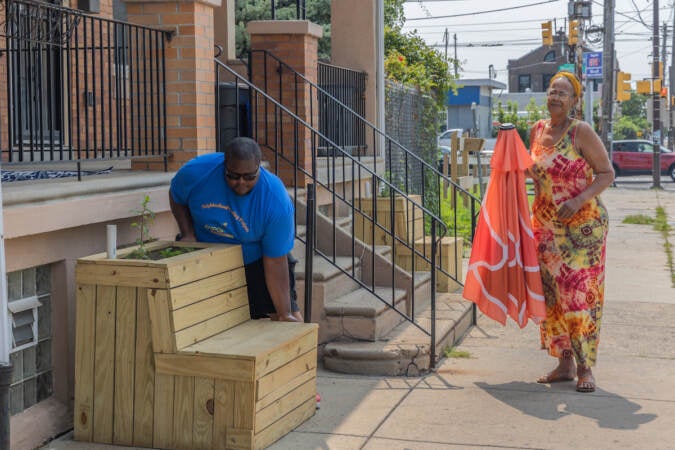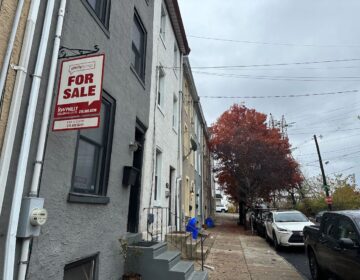Could patio umbrellas and planters help cool Philly blocks? Researchers team up with residents to find tree alternatives
Citizen scientists and Drexel researchers are testing whether planter benches make summer heat in five Philly neighborhoods more bearable.
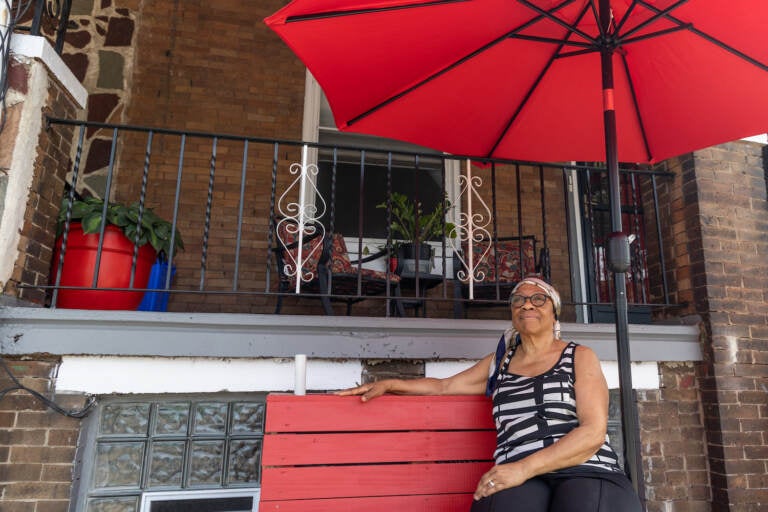
58th Street resident Sharon Drayton said that since the planter box benches were installed, she feels like there’s more community on her block. (Kimberly Paynter/WHYY)
This story is part of the WHYY News Climate Desk, bringing you news and solutions for our changing region.
From the Poconos to the Jersey Shore to the mouth of the Delaware Bay, what do you want to know about climate change? What would you like us to cover? Get in touch.
On Sharon Drayton’s block in Philadelphia’s Kingsessing neighborhood, wooden benches sit on the sidewalk in front of most of the porch-fronted, brick rowhouses.
They’re not your average benches. They’re handmade, and the back of each bench contains a built-in planter box. Attached to the side is a metal sheath to hold a patio umbrella.
“I’m really excited about mine. Everybody is, really,” Drayton said. “It’s something new, and it helps.”
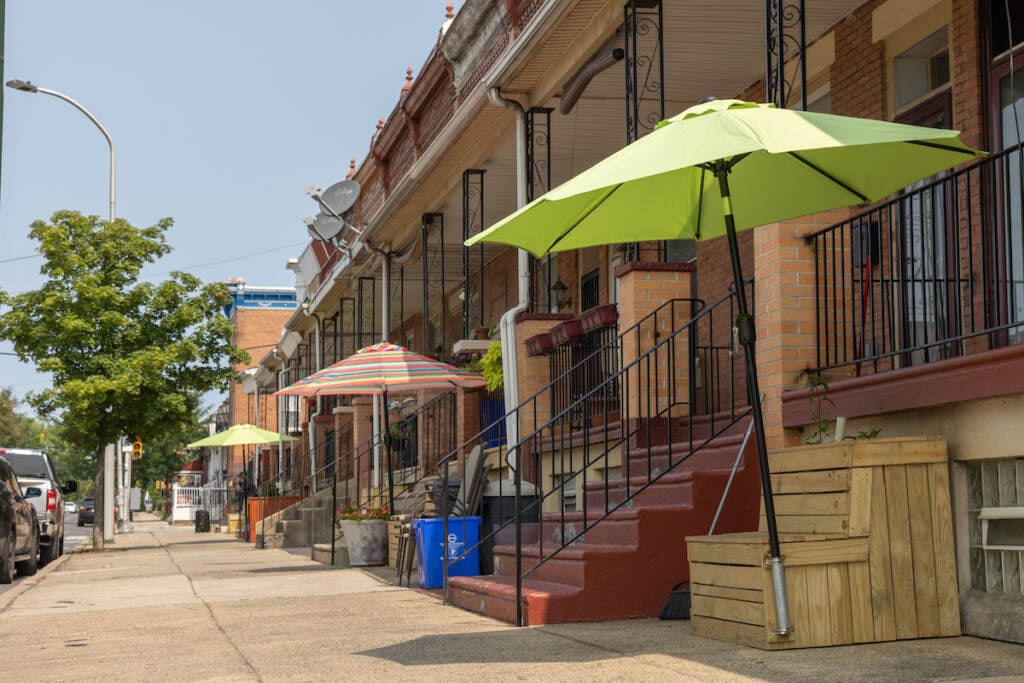
The planter benches are part of an experiment led by researchers at Drexel University to find ways to help residents of sunny Philly neighborhoods deal with summer heat, especially if those blocks lack street trees.
The project began in the Hunting Park neighborhood in 2020 and expanded this summer to Haddington, Kingsessing, Point Breeze, and Grays Ferry. In total, roughly 400 planter benches have been distributed throughout the city.
“We would love to see in the data that these things are making a difference in the temperature,” said Nikki Pearl, lab manager of Drexel University’s Sustainable Water Resource Engineering Lab and manager of the planter bench project. “But we also want to help beautify blocks, build a sense of community, add some greenspace with the native plants. … There’s really a lot of goals.”
An alternative to street trees?
The wooden benches are wide enough to seat one to two people. They’re made of plain, pressure-treated wood that can be painted or customized. The patio umbrella that shades each bench is removable, attached by a metal sheath on the side of the bench. The planter box is designed to use water efficiently, with a reservoir system, pond liner, and drainage tube.
“Anything you plant in here, … its root system will grow down into the reservoir,” said Angelo Zaharatos, an architect based in Connecticut involved with the project. “It will start wicking up the water itself, as needed.”

Philly residents interested in learning construction skills were hired to build the benches in a warehouse in Southwest Philly.
“We started from piles of wood … and we turned it into something beautiful,” said Oman Sewell, who helped build the benches and lives in one of the South Philly neighborhoods where they’re being installed.
The Drexel team worked with Zaharatos and incorporated feedback from residents of Hunting Park into the planter bench design, Pearl said.
The team hopes the planter benches lower temperatures by providing shade from the umbrellas and adding vegetation. Pearl sees them as a good option for blocks with few trees.
“Folks love trees and everyone wants more of them, but especially younger trees require a lot of watering and maintenance, and not everyone has the resources to take care of those street trees when they’re young,” Pearl said. “Just because you can’t take care of a young street tree doesn’t mean you don’t deserve shade.”
Trees help keep blocks cooler, have been associated with better health outcomes for surrounding residents, and store planet-warming carbon. But their roots have been known to tear up sidewalks and disrupt underground utilities, at a cost to homeowners.
“We wanted to give them an alternative,” Pearl said. “That’s where the design for the planter bench came from.”
The Drexel team works with community organizations — namely Empowered CDC, Global Thinking Initiatives, Inc., Point Breeze Community Network Plus, Residents Organized for Advocacy and Direction, and Esperanza — to identify the best blocks to install the planter benches. The team also offers residents sprinklers.
“We went around looking for blocks that could actually accommodate those kind of benches,” said Victoria Miles-Chambliss, secretary and treasurer of Empowered CDC. “It’s become so, so warm. And with the environment changing, what we’re trying to do is make sure that we can have an oasis right where you stay.”
‘People really like them’
Drayton painted her bench red, to match her red door and red planters. She says the umbrella helps shade her porch, but the biggest benefit of the benches is how good they look.
“We’ve been getting a lot, I mean a lot of compliments,” she said. “People really like them.”
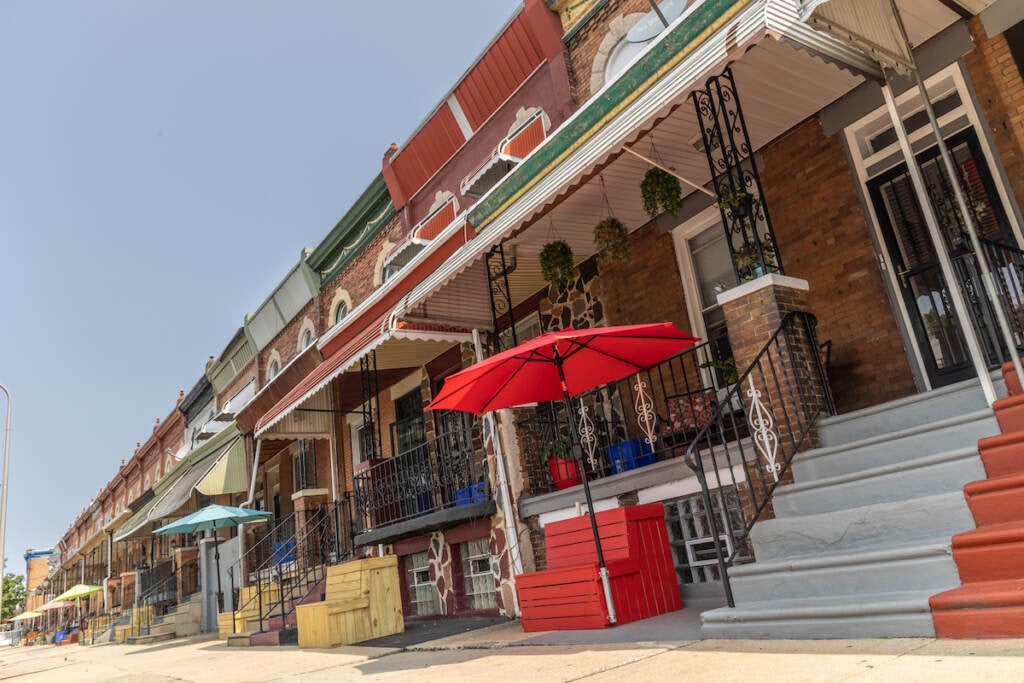
On a day in early August, few neighbors on Drayton’s block had their umbrellas attached to the benches. Adrine Wilson, who lives a few doors down, said she keeps her umbrella inside when she’s not home, because there’s no way to lock it to her bench.
“I think initially the purpose was to … lower the temperature,” Wilson said. “That was the initial function of the benches. But I think a lot of people are kind of looking for it because it looks so pretty, and plus it adds seating in front of their house, especially if they don’t have a porch.”
The benches have provided a place for residents of a nearby senior apartment building to rest while walking down the street, Wilson said. Neighbors on the block have also used the benches to sit and chat.
From the perspective of the Drexel researchers, this means the benches are doing their job.
“Already folks are saying they’re going on more walks because up and down the block, there’s benches for them to take a seat and rest,” Pearl said. “Folks are spending more time out front talking to their neighbors. … And it’s just a great way to bring some color and some beautification of blocks as well.”
Gathering hard data on the cooling effect
In the summer, Drayton and Wilson’s area of Kingsessing gets hot.
The city considers the area highly vulnerable to heat based on its temperature, its amount of vegetation, the age of its residents, the prevalence of certain health conditions that are exacerbated by heat, and other factors.
“All this concrete?” Wilson said. “We get so much heat. We get full sun. So the umbrellas were very nice. … Then you can sit outside this way. Because even when I’m on the porch, if the sun is on this side, I can’t sit outside. But with the umbrella … you can angle it.”
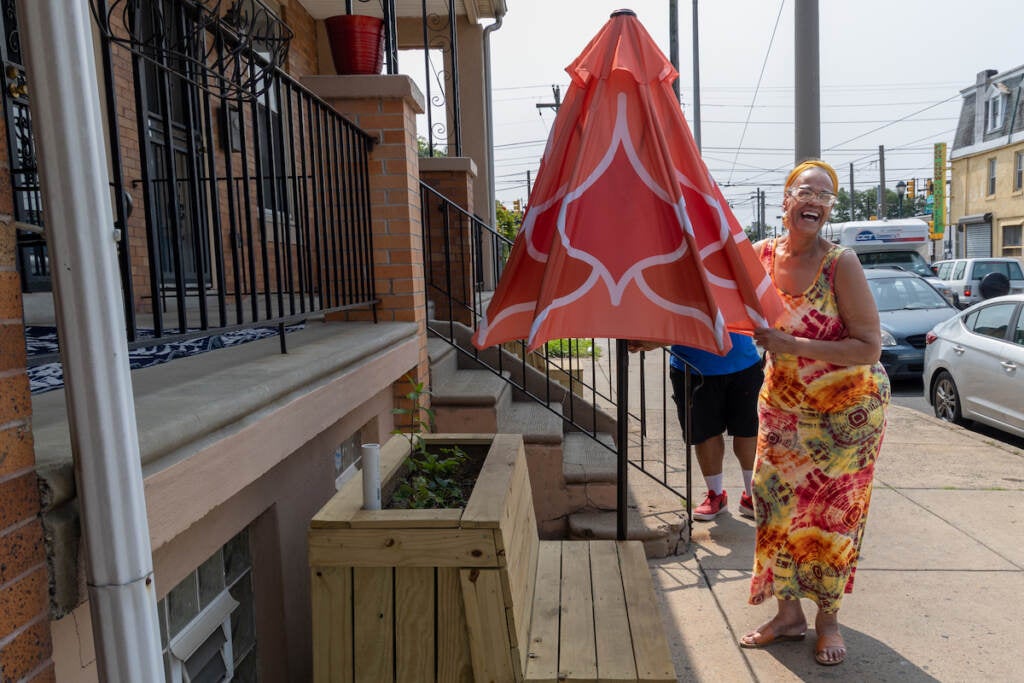
Teams of citizen scientists are helping the Drexel researchers gather data about the effectiveness of the planter benches at reducing temperatures more broadly.
In Kingsessing, about half a dozen residents hired through Empowered CDC walk a consistent route through the neighborhood daily, measuring surface temperature, WetBulb Globe Temperature, wind speed, and relative humidity.
“What that’s trying to capture is … the overall temperature,” said Jalen Busbee. “We just kind of walk in a big rectangle every day and record the data over and over.”
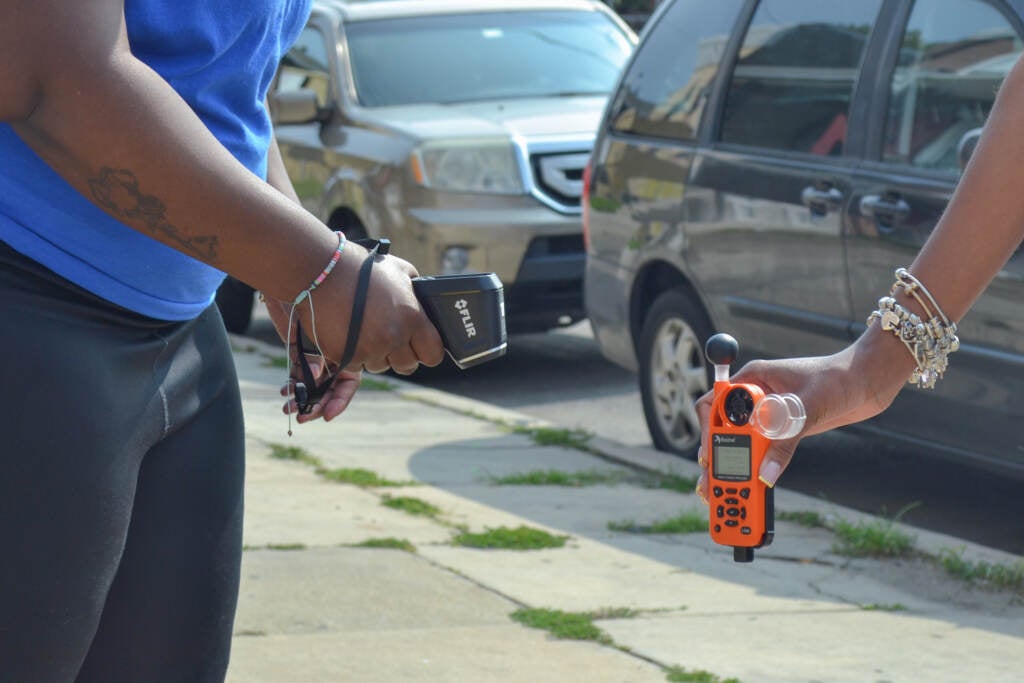
The goal is to see how different elements of the environment — including not just the planter benches, but trees and stormwater projects — impact temperature, said Lotus Barron.
“Hopefully the data that we’re collecting can prove why all of this is important for making a cooler environment, making better use of resources that we have, and fostering more of a sense of a community, too,” Barron said.
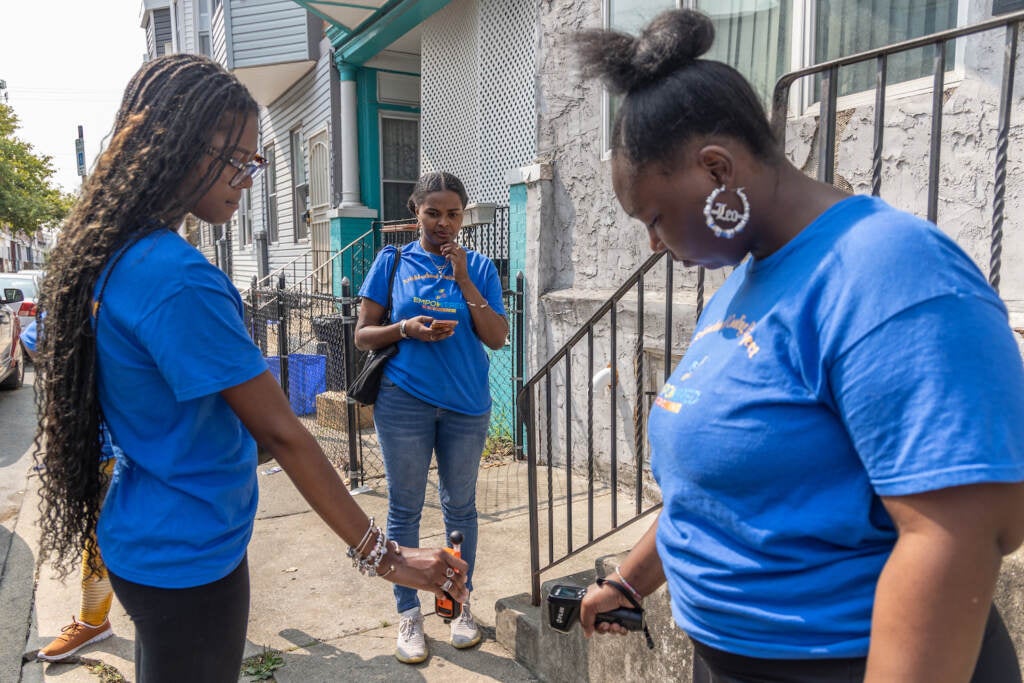
Barron said it’s nice to see people sitting outside and to see a little more shade from the planter benches along Woodland Avenue as the team walks along their route.
“We always joke that we get the Woodland Avenue tan, which is not necessarily a bad thing — we love being melanated — but it’s nice to have a little reprieve too, from time to time,” Barron said. “Hopefully, we collect all this data … basically just to impact the people and make it cooler for everyone.”
The Drexel researchers hope to finish analyzing some of the data by this winter, Pearl said.

Subscribe to PlanPhilly
WHYY is your source for fact-based, in-depth journalism and information. As a nonprofit organization, we rely on financial support from readers like you. Please give today.




